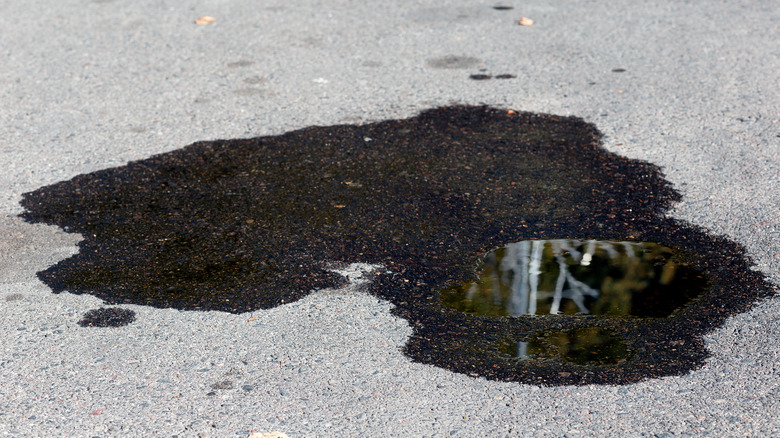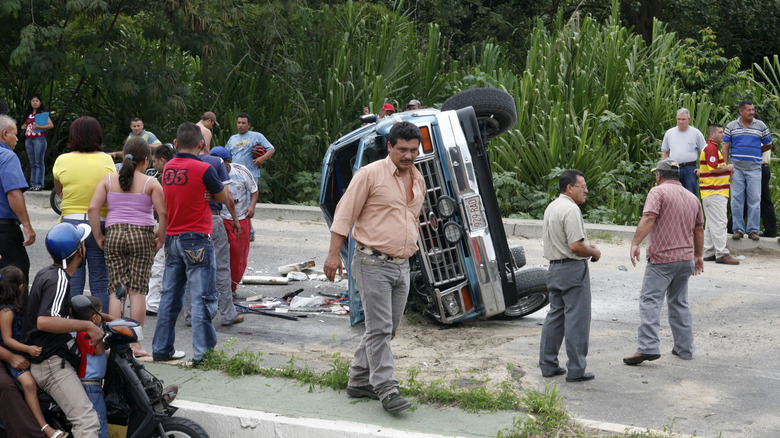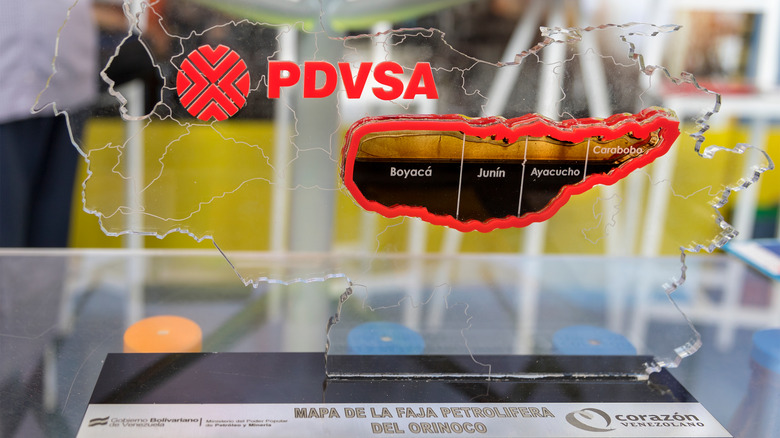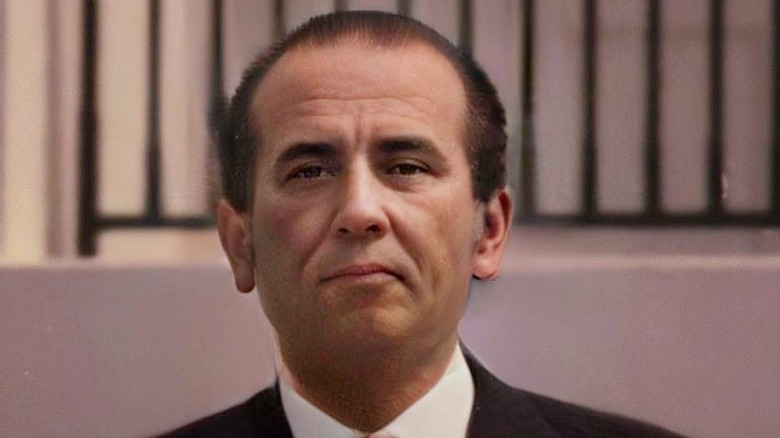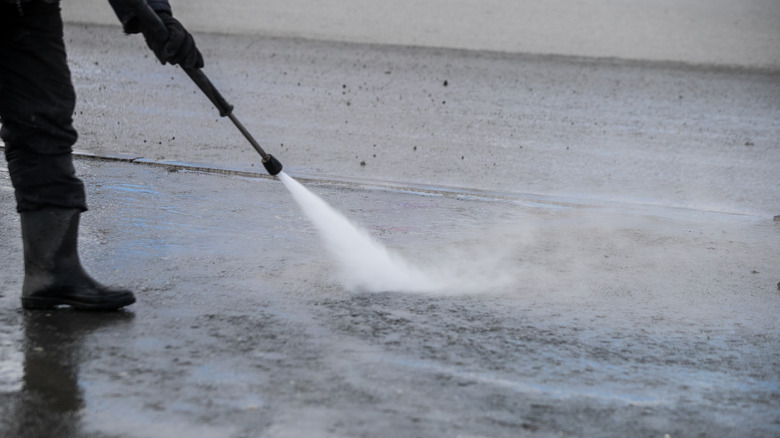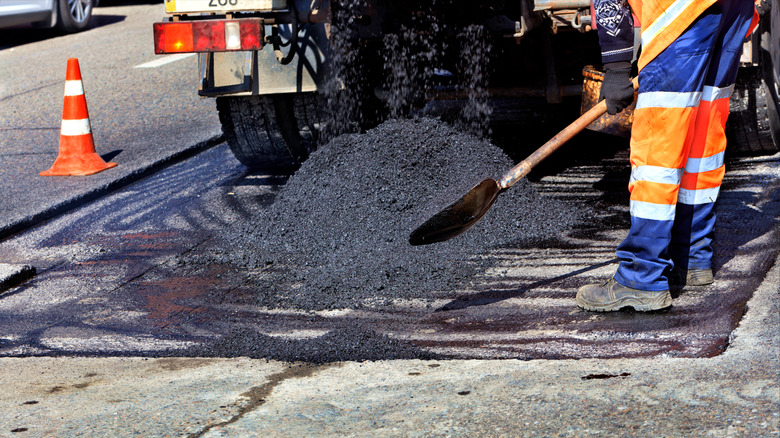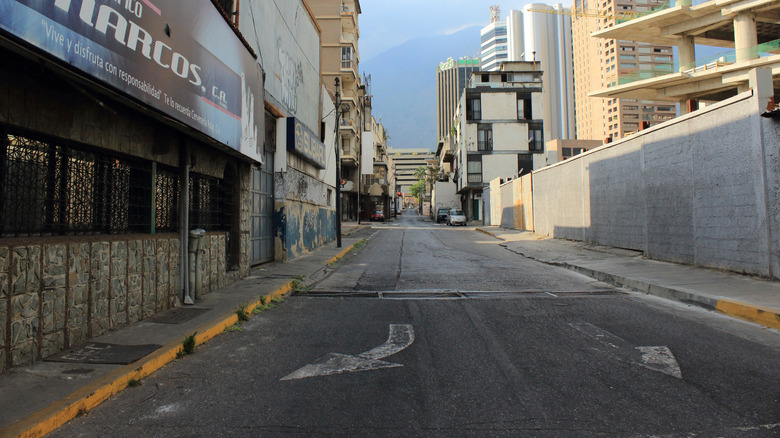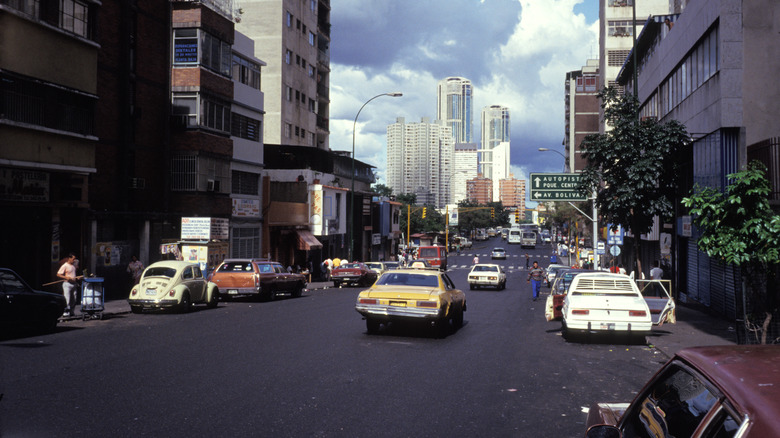Venezuela's Mysterious La Mancha Negra Is Still Unexplained
If you're into listening to podcasts or a member of Reddit groups on mysterious phenomena, you know that after a while, things can get repetitive. There are only so many events out there you can convincingly say are "mysterious" before you stray into conspiracy or just plain stupid territory. But there are still some lesser-known strange phenomena out there, and La Mancha Negra is the perfect example.
One of the reasons so few people have heard of La Mancha Negra is there is surprisingly little information out there about it, at least in English-language sources. But even with the help of trusty, if fallible, Google Translate, facts are hard to come by. Perhaps that only adds to the mystery. Or perhaps it's a sign something else is afoot.
The end result, however, is the outside world has only had a peek into this strange, deadly substance that appeared suddenly one day on a road in Caracas. What was it? How many people did it really kill? And should we still be worried about it? Read on to learn about La Mancha Negra, Venezuela's mysterious black goo.
The first appearance of La Mancha Negra
The name "La Mancha Negra" sounds like a legend deserving of a fabulously spooky origin story. Even the English translation, "The Black Spot," has plenty of creepy vibes to it. You imagine something ancient and nefarious emerging from deep in the Amazon jungle (a sliver of which is in Venezuela) to bring vengeful ruin down on the modern world.
The reality is, sadly, a lot less paranormal and a lot more pedestrian. Almost banal. According to a 1991 article in the Chicago Tribune — which was reprinted widely, including in The Baltimore Sun — a road between Venezuela's capital Caracas and the airport was looking worse for wear after 30 years. So, as you do when the public starts screaming about potholes, the government sent in a crew to fix the road.
It was during this basic repair job that the workers noticed some sort of odd goo oozing up from the road. The Chicago Tribune described the strange substance as "a blob, a thick black sludge with the consistency of chewing gum." It was a weird thing to happen, for sure, but the crew was being paid to repave the road — not investigate unexplained phenomena — so they didn't worry about it. And at first, the goo didn't really seem to be a problem since it was only found on a 50-yard stretch of road. But soon it spread until five years later, it covered 8 miles and went from no one's problem to everyone's problem.
The dangers posed by La Mancha Negra were deadly
La Mancha Negra probably wouldn't have been as big a deal if it emerged in a small village, far off the beaten path. But this goo was covering miles of the road leading from Venezuela's capital to an international airport. Lots and lots of cars had to pass over it every day, and it was not a fun experience. The Chicago Tribune (via The Baltimore Sun) spoke to Antonio Perez, a Caracas taxi driver who claimed to face the blob "frequently," who said, "Driving with La Mancha Negra is like driving in a grand prix. You got to be careful, or you'll die."
He wasn't kidding about the dying part. According to the original article in 1991, five years after La Mancha Negra first appeared, it had managed to kill 1,800 people on just one 8-mile stretch of highway. Now sure, there were lots of cars driving on that busy road in that period, but you have to admit that number is concerningly high. As a comparison, according to a study by ValuePenguin, the deadliest road in America over the four-year period 2015-2019 was I-5 in California. That highway runs the length of the state, which is exponentially more than La Mancha Negra's 8 miles. And in almost the same length of time (four years vs. five), I-5 saw only 584 people die in car crashes.
Sure, more modern cars are much safer, but even accounting for that, La Mancha Negra was exceptionally deadly.
The various theories about what caused La Mancha Negra
There are many guesses about what La Mancha Negra is composed of, including engine oil, brake fluid, dust, sewage, and underground oil deposits. While all sound perfectly reasonable, most of these theories have issues once you look at them in more detail.
According to El Nacional (via Courrier International), one Venezuelan chemist thought the blame definitely lay with oil seeping from old cars. He claimed that people push their cars for 10 or 15 years in Venezuala and all that dripping oil builds up on the roads. But it's not the only country in the world with lots of old, badly maintained cars — far from it. The same goes for dust and leaking sewage. So why only Venezuela, and more specifically, only this one stretch of road? Underground oil reserves make more sense since the Orinoco Belt borders the area and is stuffed with oil deposits. But if that's the case, why does it only seep up from the highway, and never, as Mysterious Universe points out, the surrounding ground or the nearby wilderness?
And while many people might be sure the answer to the mystery is obvious, those who actually had first-hand dealings with it didn't share that certainty. "We don't know what it is. We clean it away, and it comes back the next day," engineer Arturo Carvajal told the Chicago Tribune (via The Baltimore Sun), whose company was one of many that tried and failed to defeat La Mancha Negra.
Conspiracies surrounding La Mancha Negra
Perfectly plausible explanations for a mysterious phenomenon have never stopped people from going down the conspiracy rabbit hole, and La Mancha Negra was a perfect contender. According to El Universal, the first appearance of La Mancha Negra spanned the terms of three Venezuelan presidents. They all promised to fix it, but obviously, they failed. And what do you do when you're a politician and can't solve something? You blame the problem on your opponents.
Mysterious Universe says enemies of President Carlos Andrés Pérez (pictured above) were accused of being behind La Mancha Negra, but by 1992, he had much more obvious enemy problems in the form of an attempted coup. El Nacional reports (via Courrier International) that when La Mancha Negra returned after a five-year break in the early 2000s, the mayor of Caracas, Freddy Bernal, knew who was to blame. According to Bernal, it was a group of agitators who waited until the dead of night to drive their old trucks — with the license plates removed, of course — to this specific stretch of road and dump bags of used oil on it. Why would they go to the trouble to do something so bizarre? Sabotage, obviously. It was an act of war against the residents of the city. A town hall spokesman said other residents had snitched on the oil vandals, and the city was looking into their legal options.
If you think that conspiracy is too far-fetched, some people believe aliens are responsible for La Mancha Negra. It's always safer to stick with a classic.
La Mancha Negra comes and goes
La Mancha Negra isn't just mysterious because it appeared suddenly one day and no one can figure out what it is. It is also mysterious because it comes and goes. La Mancha Negra does not care about your schedule — it will seep out of the asphalt when it wants to and seep right back in when that takes its fancy. You can try to understand it, but you will fail, because La Mancha Negra has an inexplicable schedule befitting a substance beyond human understanding.
But as sources like Libretilla and Mysterious Universe point out right after mentioning its completely unfathomable appearing and disappearing: It tends to seep onto the road when it's hot and humid out, and it's less of a problem when it's cold and dry. So you would think this would be less the most unpredictable of mysteries and more one that could essentially be solved by checking the weather before heading to the airport. Still, if drivers are only safe from La Mancha Negra on cold days, it makes sense that it was such a problem. Indeed, Caracas is basically never cold, with temperatures usually ranging from the 60s to the 80s (in Fahrenheit).
One extra detail Mysterious Universe adds is that La Mancha Negra is picky about location as well, as it usually appears "in tunnels and on uphill slopes rather than on flat, open terrain." However, it's not clear where Mysterious Universe found this information, and it's not in the original Chicago Tribune article from 1991 (via The Baltimore Sun).
Attempts to get rid of La Mancha Negra
While the reason behind La Mancha Negra's existence may never be known, the people who interacted with it knew that it needed to go. Whether the black goo is the result of oil or aliens is unimportant when you just want to make it to the airport without dying. And, ideally, survive the drive back home after your vacation as well. So cleaning crews were dispatched to get rid of the problem once and for all. And when that failed, they tried a second time. And so on. La Mancha Negra, it seemed, had no intention of going anywhere.
The Venezuelan Ministry of Transport and Communications hired more than half a dozen engineering firms, according to The Chicago Tribune (via the Baltimore Sun) and they took their shots at clearing away the goo. At first, it was thought just washing it away would be enough, so much so that Libretilla says the cleaning crews suspended work when it rained, assuming it would clear the road for them. When that failed, Today I Found Out reports they moved on to "pressure washing it with detergents and simply scraping the goo off in layers."
Eventually, they went with the nuclear option: pouring ground up limestone on the road in an attempt to dry the goo up. It worked — for a bit — but the unintended side effect was so much dust that air quality plummeted.
Was corruption involved in this mystery?
La Mancha Negra seemed to be invincible. How did so many companies try so hard to defeat this sticky goo and yet nothing worked? Well, that answer might be less mysterious than La Mancha Negra itself: What if they weren't actually trying very hard to succeed? What if it was just down to good old-fashioned corruption every time La Mancha Negra reappeared?
As Mysterious Universe points out, all these local companies were getting repeat business clearing away the goo. Failing once or twice might mean a bigger paycheck in the end. And the crew that appeared to have the most luck clearing it came from Germany, so maybe they didn't have as much of an incentive of repeat business. Either way, their solution only managed to control La Mancha Negra for five years.
There's also the small matter that the 1991 Chicago Tribune story (via The Baltimore Sun) says that "millions of dollars" were spent by the Venezuelan government to figure out what La Mancha Negra was, but the initiative failed. Knowing what the substance was made of would definitely have made it easier to clean up and probably solved this mystery to boot. Seriously though, millions spent studying La Mancha Negra and they couldn't identify it at all? Even in the late 1980s, technology wasn't so bad that it should have been that hard. As Today I Found Out says, isn't it more likely that millions supposedly went towards this issue, but really went into the pockets of politicians?
The most likely explanation for La Mancha Negra
Despite all the mystery that built up around La Mancha Negra over the years, much like the black goo itself built up on the roadway, there's one explanation that makes more sense than others. Yes, more sense than oil-in-a-bag-based guerrilla warfare, more sense than aliens, even more sense than castoff from old cars.
The one thing you can't get away from when thinking about La Mancha Negra's cause is that it was first seen by a road crew. You know, the ones who were putting down new asphalt on the exact same highway where La Mancha Negra would emerge from that new asphalt and literally nowhere else for years to come. The answer has been staring you in the face the whole time: The asphalt the crew was using was possessed by a demon.
Or, much less exciting, maybe the company laying the road was cutting a few corners and using subpar asphalt. As Today I Found Out explains, this would account for most of the weird properties of La Mancha Negra. It's supposed to have a chewing gum consistency yet be very slippery, just like tar. It expands and gets even more slippery when it's hot out — just like tar. You get excess tar seeping out like that when asphalt is mixed badly, and you'd have a chance to get that bad new asphalt from a road crew repaving the highway. There could be more to it, but on essentials, the theory fits.
Or it could be aliens.
Is La Mancha Negra still a problem?
One of the weirdest things about La Mancha Negra is how little coverage there seems to be about it. If we're talking about an 8-mile stretch of road that was killing an average of one person a day for five years, this should have been huge news, right? But while the 1991 Chicago Tribune article (via The Baltimore Sun) was apparently syndicated widely at the time, there isn't evidence some plucky investigative reporter went to Venezuela to follow up on this pavement-as-envisioned-by-Stephen-King.
After the 1991 article, references are sparse. The Spanish-language website Libretilla mentions it returning in 1996 and 2001. But as the article was published in 2018, you do have to wonder what, if any, havoc La Mancha Negra has been causing in the past two decades. Did a cleaning team in the early 2000s manage to get rid of the issue for good? If that's the case, did they win medals of some kind for ridding the country of this gooey serial killer? Other cleaning teams had already tried and failed. A successful attempt that saved thousands of lives over the past 20 years would be a historic victory over mysterious viscous phenomena. Why so little coverage?
Others have looked and failed to find answers as well, including websites like Mysterious Universe and Today I Found Out. The consensus seems to be that clickbait articles often say La Mancha Negra is still around, but there's no hard evidence for this. Like, no evidence at all. So if you live in Venezuela, you could break a big story.
Is La Mancha Negra a myth?
The fact that evidence from legitimate, non-clickbait, non-mysterious-phenomena-centric sources is so scarce leads to the obvious question: Was La Mancha Negra ever a issue at all? Or is this just a weird conspiracy theory, one meant to make people distrust ... "Big Asphalt"? Was it a hint of something true that over the years became lost in a crazy story?
The weird thing is, most coverage in English leads back to the 1991 Chicago Tribune article. The Tribune is not a tabloid, and wasn't in the '90s, either. It was founded in 1847, is the biggest newspaper in the Midwest, and has won 27 Pulitzers. Of course, there are journalists at legitimate news outlets who have embellished news stories until they are barely true at all. So did a bored reporter, or one on a tight deadline, make up a death toll to spice up a bland story? After all, at the end of the day, this is a story about bad road work on a different continent. The enormous death toll is probably the only thing that got the story syndicated all over. But if it was made up, why did none of the fact-checkers at the paper notice? And in the three decades since, no one has found proof it was exaggerated? It seems impossible.
So did 1,800 motorists really die on this one very slippery stretch of road? Unless people in Venezuela start talking, we may never know.

